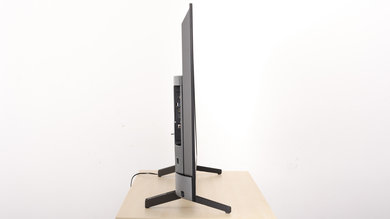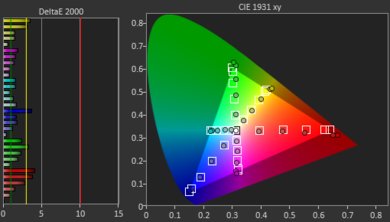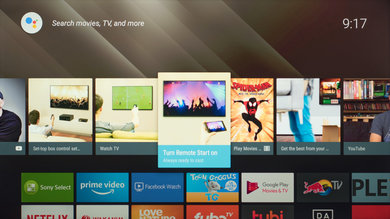Our Verdict
The Sony X800G is a decent TV for most uses. It is well-suited for a bright room, with wide viewing angles, but doesn't look as good in a dark room. It has very good motion handling, with an excellent response time, but has limited motion processing options, and can't remove judder from all sources. It has relatively low input lag, which is fine for casual gamers, but may disappoint more serious gamers.
- Image remains accurate at an angle.
- Very good motion handling.
- Blacks look gray in a dark room.
- Higher than average input lag.
The X800G is a mediocre TV for watching movies in a dark room. The contrast ratio is too low to produce deep blacks, and this is especially noticeable in a dark room, and blacks appear gray. This model also lacks a local dimming feature, and has disappointing black uniformity. It upscales 1080p content well though, great if most of your movies are on Blu-ray, and it can remove judder, but only from true 24p sources.
This is a great TV for watching TV shows during the day. It has wide viewing angles, good reflection handling, and good peak brightness, which is great if you like to move around with the TV on during the day. The smart platform has a huge selection of apps, and most streaming services are available. This TV also upscales older, lower resolution content really well, and TV shows on Blu-ray look great.
This is a very good TV for watching sports during the day, especially as a group. It has wide viewing angles, good peak brightness, and good reflection handling, great for watching the big game with a group of friends. It has a fast response time, so there is minimal blur behind fast moving objects (or players), and it has decent gray uniformity.
The X800G is a good TV for playing video games, especially console games. It has a fast response time, so there is little blur behind fast-moving objects in your favorite games, and although it has low input lag in Game mode, it is higher than most TVs currently on the market. Unfortunately, this TV doesn't support any advanced gaming features, such as a variable refresh rate, and it has a 60Hz refresh rate, which may disappoint some gamers.
Unfortunately, the X800G is a mediocre TV for watching HDR movies in a dark room. The contrast ratio is very low, so blacks look gray in a dark room, and it lacks a local dimming feature to compensate for this. This isn't as noticeable in a bright room though. It can display a wide color gamut, which is great, but it can't get very bright in HDR, so bright highlights don't stand out as much as they should.
This TV is decent for HDR gaming, mainly due to the fast response time and relatively low input lag. Unfortunately, it has a mediocre contrast ratio, no local dimming, and disappointing black uniformity, so it isn't ideal for gaming in a dark room. It can display a wide color gamut, which is great, but has mediocre color volume, and can't get very bright in HDR.
The Sony X800G is a great TV for use as a PC monitor. It has an excellent response time, so there is little distracting blur behind moving objects, including the mouse pointer. The image remains accurate when viewed at an angle, which is great if you are sitting close to it, as the sides of the screen remain uniform. It can display proper chroma 4:4:4 with 1080p, 1440p, and 4k content, and it can use nearest neighbor upscaling when sent a 1080p signal, which some people prefer. Unfortunately, it has higher than average input lag, which may disappoint some people.
Changelog
- Updated May 21, 2020: Converted to Test Bench 1.5.
- Updated Feb 21, 2020: Converted to Test Bench 1.4.
- Updated Jul 03, 2019: Review published.
- Updated Jul 01, 2019: Our testers have started testing this product.
Check Price
Differences Between Sizes And Variants
We tested the 55" X800G (XBR-55X800G), and we expect our results to be valid for the 43" (XBR-43X800G), 49" (XBR-49X800G), 65" (XBR-65X800G), and 75" (XBR-75X800G) as well.
The 43" and 49" models are advertised by Sony as edge-lit, which may affect some results.
If someone comes across a different type of panel or if their Sony X800G doesn't correspond to our review, let us know and we will update the review. Note that some tests such as the gray uniformity may vary between individual units.
| Size | US Model | Alternative Name | EU Model |
| 43" | XBR43X800G | XBR-43X800G | KD-43XG8096 |
| 49" | XBR49X800G | XBR-49X800G | KD-49XG8096 |
| 55" | XBR55X800G | XBR-55X800G | KD-55XG8096 |
| 65" | XBR65X800G | XBR-65X800G | KD-65XG8096 |
| 75" | XBR75X800G | XBR-75X800G | KD-75XG8096 |
Update 07/11/2019: We have received information that the 75" model (XBR-75X800G) has a VA panel. It likely has much better contrast and better black uniformity, but a worse viewing angle.
The X800G we reviewed was manufactured in April 2019.
Popular TV Comparisons

The X800G is a basic 4k TV with decent performance. It is a minor upgrade over previous models. See our recommendations for the best TVs, the best smart TVs, and the best sounding TVs.
The Sony X800H is better than the Sony X800G. The X800H can get much brighter, the viewing angles are significantly better, and there's minimal dirty screen effect, which is distracting with fast-moving objects. The X800G handles reflections slightly better and the response time is slightly quicker, but the input lag is much lower on the X800H. Overall, the X800H is an improvement over its predecessor, the X800G.
The Sony X950G is a much better TV than the Sony X800G. The X950G has much deeper blacks, local dimming, much higher peak brightness, better black uniformity, better motion handling, and uses a newer and smoother version of Android TV for its smart interface. On the other hand, the X800G has much wider viewing angles thanks to its IPS panel (in every size except 75").
The Sony X900F and Sony X800G use different panel types, each with their own strengths and weaknesses, but overall, the X900F is much better. The X800G uses an IPS panel, which delivers much wider viewing angles, but doesn't look as good in a dark room. The X900F, with its VA panel, looks better in a dark room, as blacks look black. The X900F also has a decent local dimming system, is much brighter, and has a fast response time than the X800G. The X900F can remove judder from all sources, which the X800G can't do.
The Samsung Q60T is better than the Sony X800G for most uses. The Samsung's VA panel has much better dark room performance, and its color accuracy and uniformity are also a lot better. The Samsung has a higher peak brightness and lower input lag, but the Sony has a faster response time and better build quality.

We buy and test dozens of TVs yearly, taking an objective, data-driven approach to deliver results you can trust. Our testing process is complex, with hundreds of individual tests that take over a week to complete. Most of our tests are done with specially designed test patterns that mimic real content, but we also use the same sources you have at home to ensure our results match the real-world experience. We use two main tools for our testing: a Colorimetry Research CR-100 colorimeter and a CR-250 spectroradiometer.
Test Results

The X800G is an entry-level 2019 LED TV from Sony. It's the direct replacement for the 2018 XF8096 Series TV, which was never released in North America, and is very similar to the X750F. Its main competitors this year are the Samsung RU7100, TCL 6 Series R617, and the Vizio V Series 2019.
The Sony X800G has a great design. It looks almost identical to last year's X750F, but with a matte black stand instead of a silver one. The stand supports the TV well, but does wobble a bit, and the legs are nearly the same width as the TV and can't be reversed. The back of the TV is plain, and there is only minimal cable management through the back of the feet. The TV has good build quality, and we didn't notice any issues or areas of concern with our unit.
The back is plain, but appears well-built. Like the X750F, there is only basic cable management, through a hollow section on the back of each foot. Some of the inputs are down-facing in a cut-out on the back, and they might be difficult to access when wall-mounted.
The Sony X800G has good build quality. The external panels are a mix of metal and plastic, and we didn't notice any issues or areas of concern. There is a slight backwards tilt on our unit; we don't know if this is a flaw with our unit, or intentional. Either way, it's very minor and not noticeable.
Update 07/11/2019: We have received information that the 75" model (XBR-75X800G) has a VA panel. It likely has much better contrast.
Like the majority of IPS TVs, the X800G has a mediocre contrast ratio. This isn't very noticeable in a bright room, but when watching in a dark room, blacks appear gray. Unfortunately, there is no local dimming feature to improve the contrast ratio.
The Sony XBR-55X800G does not have a local dimming feature. The above video is provided for reference only. According to Sony's website, the 43" and 49" models are edge lit.
The X800G has good peak brightness in SDR, and is brighter than the X750F, but not quite as bright as the X800E. This TV is bright enough for most rooms, but might not be bright enough to overcome direct glare from a nearby window. There is no variation in brightness with different content, which is great.
We measured the peak brightness after calibration, using the 'Custom' Picture Mode and the Color Temperature set to 'Expert 1'.
If accuracy isn't as important to you, with the 'Vivid' Picture Mode, the X800G is able to reach a peak brightness of 440 cd/m², as measured with the 100% window.
Decent HDR peak brightness, but bright highlights in some scenes don't stand out as much, as they aren't as bright as they should be. Like in SDR, the X800G is slightly brighter than the X750F, but not as bright as the X800E.
We measured the peak brightness before calibration, using the 'Cinema Pro' Picture Mode and the Color Temperature set to 'Expert 2'.
If accuracy isn't as important to you, with the 'Vivid' Picture Mode and Adv. Contrast Enhancer on 'High' , the X800G is able to reach a peak brightness of 470 cd/m², as measured with the 50% window.
Update 07/11/2019: We have received information that the 75" model (XBR-75X800G) has a VA panel. It likely has a worse viewing angle.
Like most IPS TVs, the X800G has very good viewing angles. At wide angles, the image loses brightness, and the image gradually looks more and more washed out. Colors gradually wash out, but remain accurate until a very wide angle. Its successor, the Sony X800H, has much better viewing angles.
Update 07/11/2019: We have received information that the 75" model (XBR-75X800G) has a VA panel. It likely has much better black uniformity.
The Sony X800G has disappointing black uniformity. There is noticeable clouding around our test cross, covering almost the entire screen. Unfortunately, there is no local dimming feature.
With our pre-calibration settings, the X800G has decent accuracy. There are some noticeable errors in almost all colors, as well as brighter shades of gray. Gamma is very close to the target of 2.2, which is great.
After calibration, colors are more accurate, and the white balance is significantly improved. There are still a few inaccuracies that some people might notice, but overall accuracy is excellent. Gamma is almost perfect, and the color temperature is much closer to our target of 6500 K.
See our recommended settings here.
1080p content looks excellent, almost as good as native 4k content. Nearest-neighbor upscaling is available for 1080p content, by selecting the 'Graphics' Picture Mode
The Sony X800G has a good color gamut, and unlike the X750F, it can display a wide color gamut, which is great for HDR content.
The HDR EOTF follows the target PQ curve well, but like many Sony TVs, including the X800E and X750F, dark scenes are over-brightened a bit. In 'Game' mode, the EOTF is nearly identical.
If you find HDR too dim, check out our recommended settings here. With these settings, HDR content appears much brighter on the X800G, as shown here.
Mediocre color volume. It can't display deep, saturated colors due to the low contrast ratio, and like most LED TVs, it can't produce very bright blues, although this shouldn't be very noticeable.
Great gradient performance, but there is noticeable banding in all colors, especially in greens and shades of gray. Unfortunately, there is no smooth gradation feature to remove any imperfections.
There are no signs of temporary image retention, even immediately after displaying our high-contrast static test image for 10 minutes, which is great.
We don't know why the image appears red. It isn't as red in real life, and we suspect that this is an issue with the color temperature changing at low brightness levels, which is exaggerated by our over-exposed image.
We did notice a persistent flicker after displaying content with a flicker in it. This is similar to what we saw on the LG 27UK650. Although not very noticeable with most content, it might be noticeable in some rare cases.
Although some IPS panels can suffer from temporary image retention, this doesn't appear to be permanent as seen in our long-term test.
The Sony X800G has an optional black frame insertion feature that can help improve the appearance of motion, by reducing the amount of time each frame appears on screen. Like the X800E, it can only flicker at 120Hz, which causes duplications in 60Hz content, which might bother some people.
The X800G has a 60Hz panel, and can interpolate lower frame rate content up to 60Hz. Some artifacts are noticeable in intense scenes, but it looks smooth.
See here for the settings that control the X800G's motion interpolation feature.
Since this TV has a slightly slower response time, there is less noticeable stutter when watching 24p content, like movies.
The X800G can only remove judder from native 24p sources, and does not require any additional settings to do so. It can't remove judder from the native apps, or from 60p/i sources, like a cable box.
The Sony XBR-55X800G has a simple 60Hz refresh rate, and doesn't support any of the variable refresh rate technologies, like FreeSync or HDMI Forum VRR.
The Sony XBR55X800G has very good input lag in Game mode, good enough for slower-paced games, but it is higher than most similar TVs currently on the market, and it might disappoint more serious gamers.
The X800G supports many of the more common formats, but is limited to 60Hz. All supported resolutions display chroma 4:4:4 properly, but only on HDMI ports 2 & 3, and with the 'Game' or 'Graphics' Picture Mode. Like many other Sony TVs, these two ports are the only full bandwidth ports.
Like the X750F, when using the 'Graphics' Picture Mode the X800G uses nearest neighbor upscaling when sent a 1080p signal.
The analog audio out port can also be used as a subwoofer port.
Unlike more advanced Sony TVs, this TV does not support Dolby Vision HDR. Sony advertises this TV as HDCP 2.3 compliant, but we don't currently have a way to test for this.
Like the Sony A8G, this TV can play lossy Dolby Atmos as a Dolby Digital Plus signal from the native Apps, including Netflix.
This TV does not support eARC.
Mediocre frequency response on this TV. The Low-Frequency Extension is bad, at about 134Hz, which indicates that the bass produces no thump or rumble, and has almost no punch. The frequency response above the LFE is very good and flat, which is important for clear and intelligible dialog. This TV can get quite loud, without producing too much compression and pumping artifacts, which is great.
The distortion performance of this TV is mediocre. At lower volume levels, the total distortion is good, and not very noticeable, but at max volume the total distortion increases drastically and is much more noticeable.
Like the A8G, the X800G ships with Android 7.0, which is strange, as older Sony TVs have already been updated to Android 8.0. The 7.0 interface is well organized, but it isn't smooth, and some basic tasks take longer to do than on Android 8.0.
The Android 8.0 update has started rolling out in batches, depending on the TV's serial number. Once our unit receives the update, we will update our review.
The interface is currently ad-free, but once the Android 8.0 update rolls out we expect there to be ads, as seen on the A9G. There is a row of suggested content at the moment, but this can be completely disabled. We will update our review once the update has been installed.
The remote is the same basic Sony remote as older Sony TVs, and some 2019 models, including the A8G. This version of the remote requires direct line-of-sight to the TV, despite supporting Bluetooth connectivity, which is required for the integrated voice control feature.














































